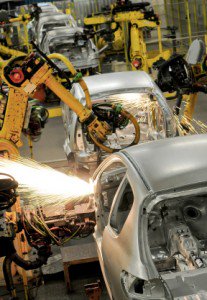
Manufacturing Renaissance in the U.S.?
Mark Colzani | 26 July 2012
It wasn’t all that long ago U.S. manufacturing prowess was the envy of the world, but then numerous U.S.-based companies decided to move their manufacturing operations abroad due to world competition and cost constraints. This led many economic analysts to disregard manufacturing as a consequential component of the United States' economic future. In recent years, however, a fascinating and somewhat silent trend has developed; U.S.-based manufacturing is making an exciting and notable comeback.
This encouraging trend is seen in vertical industries across the board including automotive, electronics, and general appliances. The intriguing question then becomes why has this trend in manufacturing apparently changed course yet again? Many economists and business leaders have offered their opinions including rising labor costs in China, increasing costs to ship products to the U.S., and the desire to more directly control the manufacturing process and the quality of the products.
Earlier this year, those sentiments were reflected in an article from the Columbus Dispatch, U.S. Manufacturing Making Comeback. Still others offer up additional reasons including higher U.S. worker productivity, supply chain and logistical advantages, quality, and other factors. While I believe each of these to be reasons for the shift in trend, one factor in my mind stands out above the rest—productivity.
The productivity growth of both the American worker and the American company has outpaced the productivity gains in most countries across the world. When examining the momentum of our increased U.S. manufacturing productivity even further, we find the use of the latest technologies through automated machinery, industrial robotics, supply chain software, material handling, and logistics are all main drivers.
Many times it gets overlooked that achieving higher productivity through the use of automated equipment and robotics leads to lower manufacturing costs and higher quality. Lower costs and higher quality allow our manufacturing companies to be more competitive, and when they are more competitive, their manufacturing operations will stay or come back to America. The positive implications of manufacturing in the U.S. are intuitively apparent.
The U.S. stands to gain 600,000 to 800,000 manufacturing jobs in the coming decade because of the return of production from abroad, according to Harold Sirkin, a partner with Boston Consulting Group. Total job gains could be 2.3 million to 3.2 million when taking into account the additional construction, transportation and retail jobs that will be needed to support the manufacturing jobs.
This trend is expected to accelerate around 2015, when the cost advantage of producing items in China for sale in North America is expected to diminish to the point where companies will begin to rethink where they make certain goods.1
While it seems the trend of manufacturing returning to the U.S. is still in the early stages, the vast opportunities for entrepreneurs and companies with top-notch manufacturing capabilities are both very exciting and encouraging. The key to remaining competitive will be continuing to increase our productivity through the creative implementation of automated equipment and software along with focusing on manufacturing lean techniques. Hopefully, over the next decade, we will see more and more of the words that helped build our country over the last 100 years...“Made in America.” ----------------
1. Reference: U.S. Manufacturing Nears the Tipping Point, BCG Perspectives, March 22, 2012
Comments
Ken Tinnell says:
8/28/2018 10:08 AM
GREAT Article!! The big companies are starting to shift those jobs already.
Tom Hall says:
8/28/2018 10:08 AM
How does the number of jobs gained in a robotic renaissance compare to the number of jobs lost when shipped overseas?
Leave a Reply
Your email address will not be published.
Comment
Thank you for your comment.